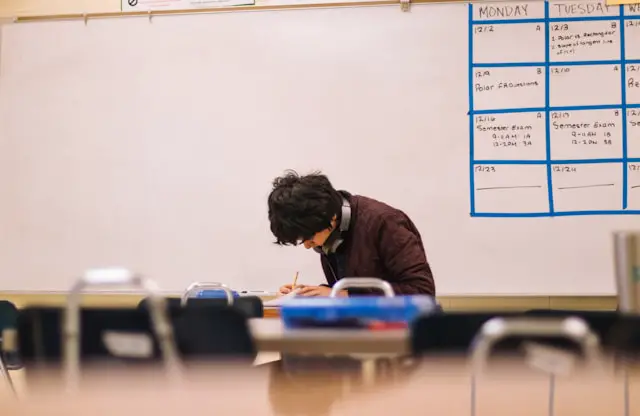
Mindfulness has become an increasingly popular practice in schools, and for good reason.
Integrating mindfulness into daily routines can help students manage stress, improve concentration, and enhance their overall emotional well-being.
In this guide, we’ll delve into why mindfulness matters for students, explore basic practices, and provide actionable tips for incorporating mindfulness into the classroom.
Why Mindfulness Matters for Students
Stress and anxiety
Stress and anxiety are common issues among students.
According to the American Psychological Association, 31% of teens report feeling overwhelmed by stress.
Mindfulness can help alleviate these problems by providing tools to manage stress effectively.
Techniques such as deep breathing and meditation can reduce cortisol levels, the hormone associated with stress, leading to a calmer and more focused state of mind.
- Read also: 6 Tips Smart Goals For Students That Can Help Students Succeed
- Read also: The Ultimate Guide: The Importance of Time management for Students
Focus and concentration
Mindfulness practices can significantly improve focus and concentration, which are crucial for academic success.
Research from Harvard Medical School suggests that mindfulness training can enhance attention and working memory, leading to better academic performance .
By teaching students to be present and attentive, mindfulness helps them stay on task and absorb information more effectively.
Emotional well-being
Mindfulness also plays a crucial role in enhancing emotional well-being.
It improves self-awareness and emotional regulation, allowing students to respond to their emotions more constructively.
A study published in the journal Mindfulness found that students who practiced mindfulness reported higher levels of emotional well-being and lower levels of emotional distress.

Basic Mindfulness Practices
Breathing Exercises
Mindful breathing is a simple yet powerful way to practice mindfulness.
One effective technique is the 4-7-8 breathing method:
- Inhale: Breathe in slowly through your nose for 4 seconds.
- Hold: Hold your breath for 7 seconds.
- Exhale: Breathe out slowly through your mouth for 8 seconds.
This technique helps calm your mind and relax your body by focusing your attention on your breath.
Body scan
This practice involves mentally scanning your body to notice any areas of tension and then releasing that tension through deep breathing.
Here’s how you can do it:
- Start at the top of your head and gradually move down to your toes.
- As you focus on each body part, consciously relax any muscles that feel tense.
- Deep breathing during this process helps you release physical and mental stress, promoting relaxation throughout your body.
Mindful movement
Engaging in mindful movement integrates physical activity with mindfulness, enhancing both physical and mental well-being.
Activities like yoga and tai chi are examples:
- Yoga: Combines gentle movements, stretches, and breathing exercises to increase flexibility, strength, and relaxation.
- Tai Chi: Involves slow, deliberate movements coordinated with deep breathing to improve balance, reduce stress, and enhance focus.
Mindfulness Activities for the Classroom
Silent 60
Start the class with a minute of silence.
Ask the students to sit quietly for 60 seconds to help them transition from the hustle and bustle of their day to a focused and calm state of mind.
This practice helps center their thoughts and sets a peaceful tone for the rest of the class.
It’s a simple way to help students prepare mentally for learning.
Powerful listening
Use a bell or another sound to engage students in focused listening.
Ring the bell and have the students listen attentively to the sound until they can no longer hear it.
This exercise enhances their listening skills and helps them practice being present in the moment.
It teaches them to pay attention and be aware of their surroundings.
One minute for good
Give students one minute to think about something positive.
It could be anything they are grateful for or something that made them happy recently.
This practice helps boost their mood and creates a positive classroom environment.
Reflecting on good things can set a positive tone for their day and encourage a more optimistic mindset.
Morning classroom conversations
Start the day with a quote and a short discussion.
Share an inspiring or thought-provoking quote with the class and have a brief conversation about it.
This activity promotes interaction among students and encourages them to start their day with thoughtful reflection.
It helps build a sense of community and sets a positive, reflective tone for the day.

Mindfulness Techniques for Specific Situations
Three breaths
Before you face a stressful situation, try taking three deep breaths.
This simple practice can help you calm your mind and body. Here’s how to do it:
- Inhale deeply through your nose, filling your lungs completely.
- Hold the breath for a moment.
- Exhale slowly through your mouth, letting go of any tension.
Repeating this three times can make you feel more centered and better prepared to handle stress.
STOP practice
This four-step mindfulness technique helps you pause and gain clarity in any situation:
- Stop: Whatever you’re doing, just pause for a moment.
- Take a breath: Breathe in deeply and then exhale slowly.
- Observe: Notice your thoughts, feelings, and any physical sensations without judgment. What are you thinking? How are you feeling? What do you feel in your body?
- Proceed: Move forward with awareness, choosing how you want to respond rather than reacting automatically.
This practice helps you become more mindful and deliberate in your actions.
5-4-3-2-1 practice
This technique grounds you in the present moment by engaging your five senses. Here’s how to do it:
- 5 things you can see: Look around and identify five things you can see. It could be anything in your environment, like a book, a tree, or a cup.
- 4 things you can touch: Notice four things you can touch. It might be the texture of your clothes, the surface of your desk, or the feel of a pen in your hand.
- 3 things you can hear: Listen and identify three sounds you can hear. It could be the hum of a computer, birds chirping outside, or distant traffic.
- 2 things you can smell: Find two things you can smell. It could be the scent of your coffee, fresh air, or a nearby plant.
- 1 thing you can taste: Focus on one thing you can taste. It might be the aftertaste of your last meal or simply the taste of your mouth.
This practice helps anchor you in the here and now, reducing anxiety and promoting a sense of calm.

Mindfulness in Everyday Activities
Mindful eating
When you eat, try to focus fully on the experience.
Instead of rushing through your meal, take the time to really notice the taste, texture, and smell of your food.
Here’s how you can practice mindful eating:
- Sit down to eat without distractions like TV or phones.
- Take small bites and chew slowly, savoring each bite.
- Notice the flavors and textures of the food. How does it taste? Is it sweet, salty, spicy?
- Pay attention to the smell of your food as you bring it to your mouth.
- Listen to your body for cues on when you’re getting full.
Eating mindfully can make meals more enjoyable and help with better digestion and portion control.
Mindful hobbies
Engaging in hobbies can be a great way to practice mindfulness.
Whether it’s painting, drawing, playing music, or any other activity, try to do it with full attention and presence.
Here’s how:
- Choose a hobby you love and set aside dedicated time for it.
- Focus on the activity itself, not on the end result. For instance, if you’re painting, pay attention to each brushstroke and the colors you’re using.
- Notice your feelings and thoughts as you engage in the hobby. Are you feeling relaxed, happy, or challenged?
- Enjoy the process and let yourself be fully immersed in what you’re doing.
These activities can be very therapeutic and help you stay present and relaxed.
Mindful physical activities
You can incorporate mindfulness into physical activities like sports, yoga, or even gardening.
By paying close attention to your movements and sensations, you can enhance the experience and benefit more from the activity.
Here’s how:
- Focus on your movements: Whether you’re playing a sport or gardening, pay attention to each movement you make. Notice how your body feels as you move.
- Tune into your breathing: Take deep, steady breaths and notice how your breath supports your activity. Inhale and exhale mindfully.
- Feel the sensations: If you’re running, feel the ground under your feet. If you’re gardening, notice the texture of the soil and plants.
- Stay present: Try to keep your mind focused on the activity and avoid letting it wander to other thoughts.
Practicing mindfulness in these activities can improve your physical and mental well-being, helping you stay connected to the present moment.

Tips for Teachers
Personal practice
It’s important for teachers to practice mindfulness themselves.
This helps you understand the techniques better and allows you to model mindfulness for your students.
Here’s why and how to do it:
- Manage stress: Mindfulness can help you handle the stress that comes with teaching. Taking a few minutes each day to meditate or practice mindful breathing can make a big difference.
- Be present: When you practice mindfulness, you become more present and attentive, which can improve your interactions with students.
- Set an example: Students are more likely to embrace mindfulness if they see their teacher practicing it. Your calm and focused demeanor can set a positive tone for the classroom.
Start with simple practices, like mindful breathing or short meditation sessions, and gradually incorporate them into your daily routine.
Flexible approach
Not all students respond to mindfulness in the same way, so it’s important to be flexible and adapt your approach.
Here’s how:
- Offer variety: Introduce different mindfulness techniques, such as breathing exercises, body scans, or mindful movement, to see which ones resonate with your students.
- Be open: Pay attention to your students’ feedback and be willing to adjust your methods. What works for one group may not work for another.
- Accommodate needs: Some students may have specific needs or preferences. Be sensitive to these and try to find mindfulness practices that are inclusive and accessible for everyone.
By being adaptable, you can help all students benefit from mindfulness, regardless of their individual preferences.
Group activities
Incorporating group mindfulness activities can build a sense of community and enhance the well-being of the entire class.
Here’s how to do it effectively:
- Guided meditations: Lead the class in short, guided meditations. Use simple scripts or mindfulness apps to guide the session.
- Mindfulness workshops: Organize workshops where students can learn about different mindfulness techniques.
- Supportive community: Encourage students to share their experiences and support each other in practicing mindfulness.
By incorporating these group activities, you can create a positive and connected classroom atmosphere where everyone benefits from mindfulness.

- Read also: Fueling the Fire: 10 Different Types of Motivation for Students
- Read also: Developing Resilience in Students: A Guide to Help Them Thrive
Conclusion
Incorporating mindfulness into the lives of students can have profound benefits, from reducing stress and anxiety to improving focus and emotional well-being.
By implementing these practices in the classroom and encouraging a mindful approach to everyday activities, we can help students develop essential skills for their academic and personal lives.
FAQs
Students can benefit from daily mindfulness practices, even if it’s just a few minutes each day. Consistency is key to seeing long-term benefits.
Yes, mindfulness can help manage exam stress by promoting relaxation and enhancing focus and concentration.
Mindfulness can be practiced by people of all ages. Techniques can be adapted to suit the developmental stage of the student.
Teachers can start with simple practices like Silent 60 or breathing exercises and gradually introduce more complex techniques.
Many books, apps, and online courses are available to help students and teachers learn more about mindfulness. Some popular apps include Headspace, Calm, and Insight Timer.


